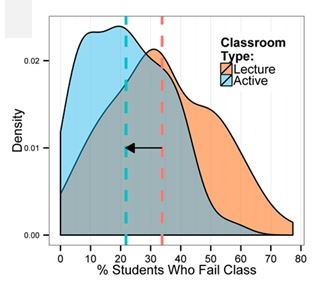
A recent study, published in the Proceedings of the National Academy of Sciences, finds that traditional lecture classes have higher undergraduate failure rates than those using active learning techniques. Biologist Scott Freeman of the University of Washington and a group of colleagues analyzed 225 studies of undergraduate STEM teaching methods. The meta-analysis concluded that teaching methods that turned students into active participants rather than passive listeners significantly reduced failure rates and boosted scores on exams.
"This is a really important article—the impression I get is that it’s almost unethical to be lecturing if you have this data," Eric Mazur, a physicist at Harvard University told Science magazine. Mazur was not directly involved in the study.
The researchers found that 55 percent more students fail lecture-based courses than classes with at least some active learning. What is considered an active learning approach? For this study active learning approaches were broadly defined to include asking students to answer questions by using handheld clickers, calling on groups or individuals randomly, or having students clarify concepts to each other and reach a consensus on an issue.
For more information visit: http://news.sciencemag.org/education/2014/05/lectures-arent-just-boring-theyre-ineffective-too-study-finds
To read the article visit: http://www.pnas.org/content/early/2014/05/08/1319030111